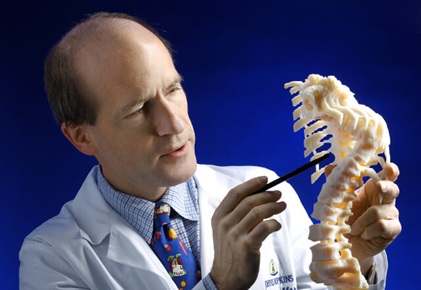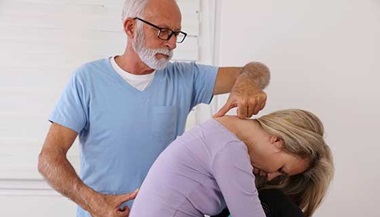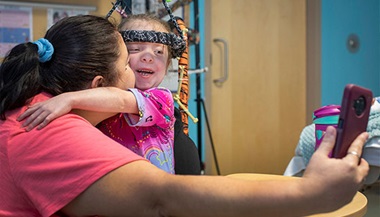Patient Story
Scoliosis: Sophie's Story
Patient Story Highlights
- Sophie’s scoliosis was caught early, so she will not need surgery.
- At Johns Hopkins, treatment for growing children with mild and moderate scoliosis takes a combined approach of proper screening, timely bracing, and customized physical therapy.
- Treating scoliosis takes teamwork between the parent, child and health care providers.
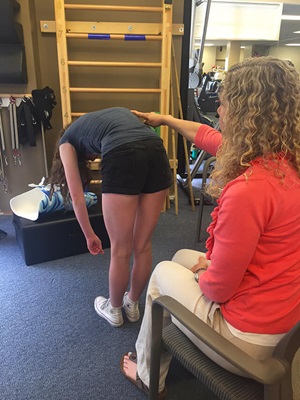
Sophie is an energetic 13-year-old who loves to act, sing and dance. Most of the time, it’s not noticeable that she has a condition called scoliosis. But when she bends over to touch her toes, the right side of her back sticks up higher than the left. If untreated, the asymmetrical curve in her spine could become more uneven as she grows.
Sophie’s mother, Robin, was the first person to notice her daughter’s scoliosis. In December 2015, Robin learned how to screen for the condition while enrolled in a physical therapy assistant training program. “Any parent can do it. You just have the child bend over and touch their toes and check to see if their back is uneven,” says Robin. “I went straight home and screened all three of my children.” When Sophie bent over, Robin could see that Sophie’s back was asymmetrical, and made a doctor’s appointment right away.
Catching Scoliosis Early
When Sophie saw an orthopaedic specialist near her home in Carroll Country, Maryland, the curve in her spine measured 13 degrees. A normal spine looks straight on an x-ray, but may have a slight lateral curve measuring between 0 and 10 degrees. If the spine curves more than 10 degrees, this is diagnosed as scoliosis. A curve between 10 and 25 degrees is considered mild scoliosis, and is often treated with a “wait-and-see” approach. But a year after her original diagnosis, Sophie’s curve had progressed to 21 degrees. At that point, Robin looked for a specialist who would take a more active approach to treating Sophie’s scoliosis. A friend recommended Johns Hopkins pediatric orthopaedic nurse practitioner Kristen Venuti.
At Johns Hopkins, “we aim to provide patient-centered care with a shared decision-making model,” says Venuti. Treatment for scoliosis should be tailored to each child, depending on the degree of curvature, expected growth remaining, age and behavior. Sophie, Robin and Kristen decided that the best approach for Sophie would be Schroth physical therapy (a special method to treat scoliosis) combined with a custom scoliosis brace that Sophie wears at night. "Each child with scoliosis is unique. If bracing is needed, we choose to team with an orthotist who is highly specialized in making spinal orthoses," says Venuti. Because Sophie’s scoliosis was caught early, she does not need to wear her brace during the day and is not expected to need surgery.
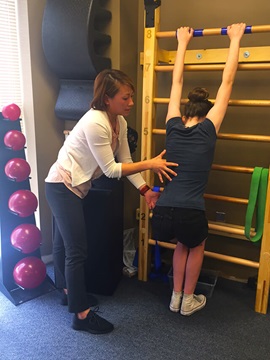
The Schroth Method
Keeping scoliosis in check is an ongoing process, so strong communication between the care team and Sophie and her family is very important. Sophie has regular appointments with Kristen every few months to measure her curve and discuss her progress. She also has biweekly physical therapy appointments with Peiting Lien, P.T., who is certified in the Schroth Method, a special program to treat scoliosis. Lien guides Sophie through a series of Schroth exercises.
The Schroth method is a three-dimensional approach that addresses scoliosis from the sagittal, frontal, and transverse planes. This means addressing the spine’s curve in three ways: left to right (frontal), front to back (sagittal), and from the rotation of the spine (transverse). Traditional physical therapy for scoliosis typically only addresses one or two dimensions with stretches and strengthening exercises. Scoliosis is a complex 3-D-deformity of the spine and trunk, so the Schroth method of treatment addresses all three dimensions by using active exercises and breathing to assist with postural correction.
“Each scoliosis curve is different, and children with scoliosis have varying levels of muscle strength and focus, so we develop an exercise series specific to each patient,” says Lien. “Sophie does a great job concentrating and following her routine.” As Sophie grows, it is important for her to continue her exercises to keep her back muscles strong to support her spine.
“At first I was nervous because I didn’t know what to expect, but the exercises are easy,” says Sophie. Robin recorded a video of Lien guiding Sophie through her exercises during her first appointment, so they could practice at home. Sophie does her exercises every night for 10 to 15 minutes. “Sophie is very diligent with her exercises, because she knows sticking with them will make a difference,” says Robin.
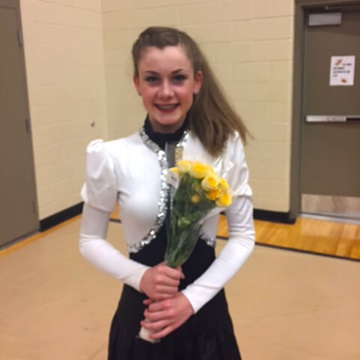
A Bright and Active Future
Sophie doesn’t let scoliosis get in the way of her daily life. She takes her brace to sleepovers. She acts in plays after school and over the summer, recently playing Babette in Beauty and the Beast. Her future is looking bright. The key is really her early diagnosis. “Without treatment, her curve had a nearly 100 percent chance of getting worse,” says Venuti. “With treatment, she has a nearly 100 percent chance of keeping her curve small.” This mild curve will not be noticeable, nor cause her any pain or limitations. Venuti and Lien believe Sophie will have a full and active life.
Meet Sophie's Treatment Team
Orthopaedic spine specialists from Johns Hopkins Department of Orthopaedic Surgery and Johns Hopkins Rehabilitation Network work together to provide comprehensive, patient-centered care for children with scoliosis.
